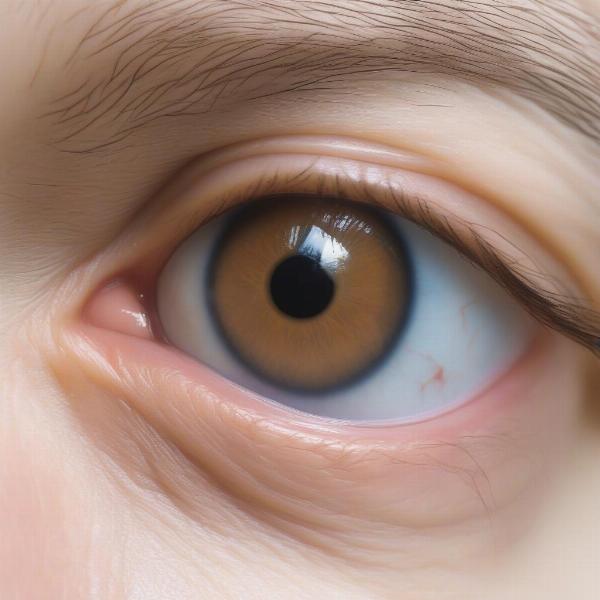Understanding the anatomy of a dog’s eye is crucial for responsible pet ownership. This knowledge empowers you to recognize potential problems early and seek appropriate veterinary care, ensuring your canine companion’s vision remains healthy for years to come. This article delves into the intricate structures of your dog’s eye, explaining their functions and common issues that may arise.
The External Structures of Your Dog’s Eye
The outer parts of the dog’s eye are the first line of defense against environmental irritants. These structures play a vital role in protecting the more delicate internal components.
Eyelids: Shielding the Eye
Just like humans, dogs have upper and lower eyelids that protect the eye from debris and excessive light. The eyelids also distribute tears, which keep the eye moist and clean.
Third Eyelid (Nictitating Membrane): An Extra Layer of Protection
Dogs possess a third eyelid, also known as the nictitating membrane, located in the inner corner of the eye. This membrane acts as an additional shield, sweeping across the eye to remove foreign particles and further moisturize the surface.
Conjunctiva: The Delicate Lining
The conjunctiva is a thin, transparent membrane that lines the inside of the eyelids and covers the exposed surface of the eyeball. It helps lubricate and protect the eye.
 Dog Eye Conjunctiva
Dog Eye Conjunctiva
Internal Structures: The Complex Machinery of Vision
The internal structures of the dog’s eye are responsible for capturing light and transmitting visual information to the brain.
Cornea: The Window to the World
The cornea is the clear, dome-shaped front surface of the eye. It refracts light, focusing it onto the lens.
Iris and Pupil: Controlling Light Entry
The iris is the colored part of the eye that controls the size of the pupil, the black circular opening in the center. The pupil dilates or constricts to regulate the amount of light entering the eye.
Lens: Focusing the Image
Situated behind the pupil, the lens further focuses the incoming light onto the retina. The lens can change shape to adjust focus for near and far objects.
Retina: Capturing the Image
The retina is a light-sensitive layer lining the back of the eye. It contains photoreceptor cells called rods and cones that convert light into electrical signals.
Optic Nerve: Transmitting Visual Information
The optic nerve carries the electrical signals generated by the retina to the brain, where they are interpreted as images.
Common Eye Problems in Dogs
Understanding common eye issues can help you detect problems early and seek timely veterinary care.
Conjunctivitis: The Pink Eye
Conjunctivitis, often called pink eye, is an inflammation of the conjunctiva. It can be caused by allergies, infections, or irritants.
Cataracts: Clouding the Lens
Cataracts are cloudy areas that develop in the lens, obstructing vision. They can occur due to aging, genetics, or underlying medical conditions.
Glaucoma: Increased Eye Pressure
Glaucoma is a condition characterized by increased pressure within the eye. It can damage the optic nerve and lead to blindness.
Protecting Your Dog’s Eyesight
Regular veterinary checkups, a balanced diet, and a clean environment can help maintain your dog’s eye health.
What can you do to protect your dog’s vision? Regular vet visits are key.
“Early detection is crucial for many eye conditions. Regular eye exams can identify potential problems before they become serious,” says Dr. Emily Carter, DVM.
Conclusion
Understanding the anatomy of a dog’s eye is essential for responsible pet ownership. By recognizing the structures and their functions, you can better identify potential issues and ensure your furry friend receives the necessary care to maintain healthy vision throughout their life. Don’t hesitate to contact your veterinarian if you notice any changes in your dog’s eyes.
FAQ
- How often should I have my dog’s eyes checked? Annual veterinary checkups usually include an eye exam. More frequent checks may be necessary for breeds prone to eye problems.
- What are the signs of eye problems in dogs? Common signs include redness, discharge, squinting, cloudiness, and changes in pupil size.
- Can dogs wear contact lenses? Yes, contact lenses can be used to treat certain eye conditions in dogs.
- Are there any supplements that can support dog eye health? Consult your veterinarian before giving your dog any supplements.
- What can I do to prevent eye injuries in my dog? Keep sharp objects away from your dog, use appropriate eye protection during activities like hiking, and trim hair around the eyes to prevent irritation.
- Can dogs go blind from cataracts? Cataracts can significantly impair vision and potentially lead to blindness if left untreated.
- Is glaucoma painful for dogs? Yes, glaucoma can be very painful for dogs.
ILM Dog is your trusted resource for expert advice on all aspects of dog care, from breed selection and health to training, nutrition, and grooming. We offer comprehensive guides and valuable insights to help you provide the best possible care for your canine companion. Whether you’re a seasoned dog owner or just starting your journey, ILM Dog is here to support you every step of the way. For personalized advice, reach out to our experts at [email protected] or call us at +44 20-3965-8624. Visit ILM Dog for more information and to explore our range of products and services.